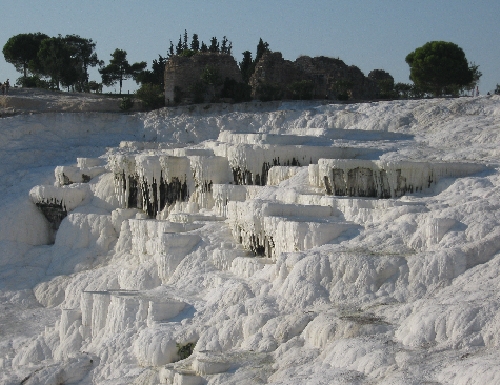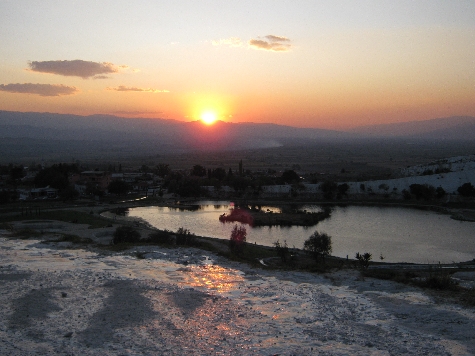
Following the visit to Ephesus, the synod members were wonderfully entertained to a barbeque supper at the nearby home of Rev’d John and Mrs Linda Skinner. John and Linda were founder members of the Northumbria Community in the North-East of England. In more recent years, they have run a small guest and retreat house just outside of the city of Selcuk and live a lifestyle that they describe as ‘New Monasticism.’ They very kindly allowed Sybille and I to stay overnight in their home when the rest of the synod members returned to Izmir later on the Sunday evening, ready for their respective flights home the next day.
We had breakfast in the sunshine on their terrace the next morning, in the company, (much to Sybille’s pleasure), of a menagerie of animals including three dogs, two cats and a horse. We then bid farewell to the Skinners and set out on the holiday part of journey, initially travelling inland to the small town of Pamukkale, in order to explore the amazing geological phenomenon that lies immediately above the settlement.
The name Pamukkale means ‘Cotton Castle’, an apt description of the hillside above the town. For thousands of years, several hot springs have released water, saturated with calcium carbonate, which has then run down the hillside, leaving snow-white deposits of a rock known as travertine. When one first views the hillside, it appears as though it is covered in slowly melting ice cream.
These hot springs have been used as a spa since the second century BC with the Greco-Roman town of Hierapolis being built on the top of the hillside. People came for the supposed curative powers of the spring water, the golden age of the city being during the first three centuries AD when it was visited by more than one Roman Emperor. With the collapse of the empire and with also suffering earthquake damage, it fell into ruin.
In the second half of the twentieth century, this whole area was rediscovered by travellers. Hotels were built, partly on top of the ancient remains of Hierapolis, and some of the hot spring water diverted into hotel swimming pools for guests to swim in. When I visited in 1975, I stayed in one of these hotels and swam in the swimming pool, not ever realising that my hotel was sitting on top of an ancient Greco-Roman city! It was also possible then, to freely walk across all parts of the white hillside with the warm spring water running across it.
In 1988, Hierapolis-Pamukkale was declared a UNESCO World Heritage Site and the Turkish government was forced to take action to conserve and preserve it. The hotels on top of the hill, which had almost certainly been built illegally, were demolished and visitors, who wish to stay overnight now, have to (as we did), use hotels within the town of Pamukkale itself. Both the hillside and the remains of Hierapolis have been fenced off and an entrance fee is now charged. Non-Turkish visitors are charged an entrance fee which is twice that charged to native Turks. If Turkey ever succeeds in its declared goal of becoming an EU member, that is one thing that will have to change!
It is still possible to walk across the snow-white hillside and paddle in the shallow pools of warm spring water. But the whole area is now closely supervised and there are restrictions on the areas you may walk upon. All this must also be done in bare feet as shoes are completely banned. Hopefully these actions will help preserve this amazing phenomenon so it may be enjoyed by future generations as much as we enjoyed it on our visit on the afternoon and early evening of Monday 12th October 2009.

